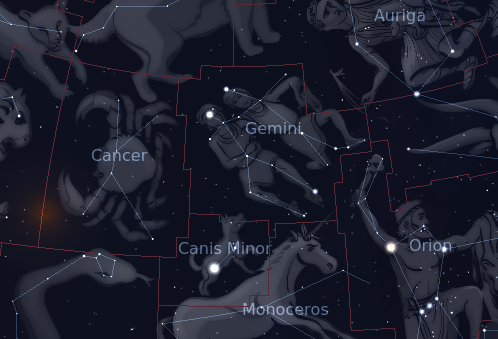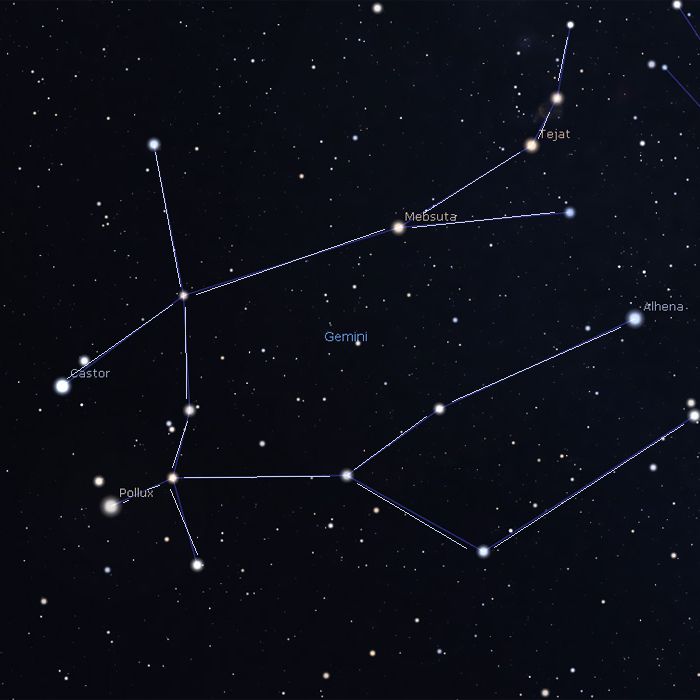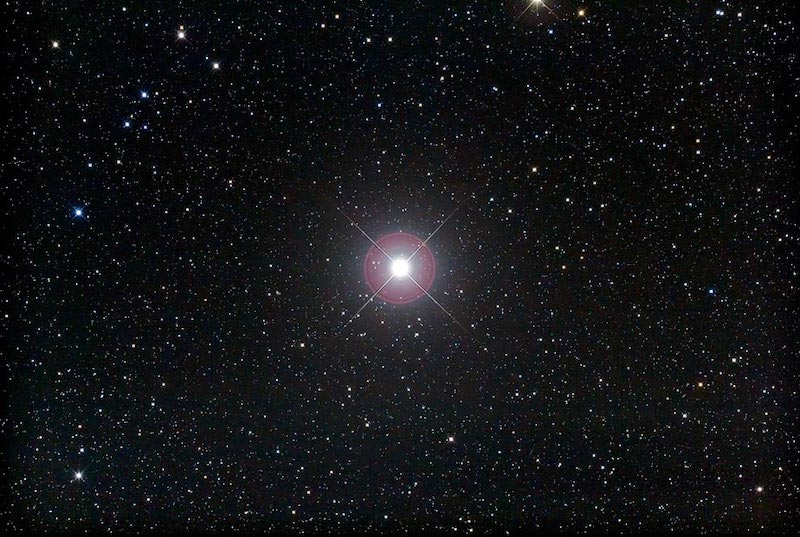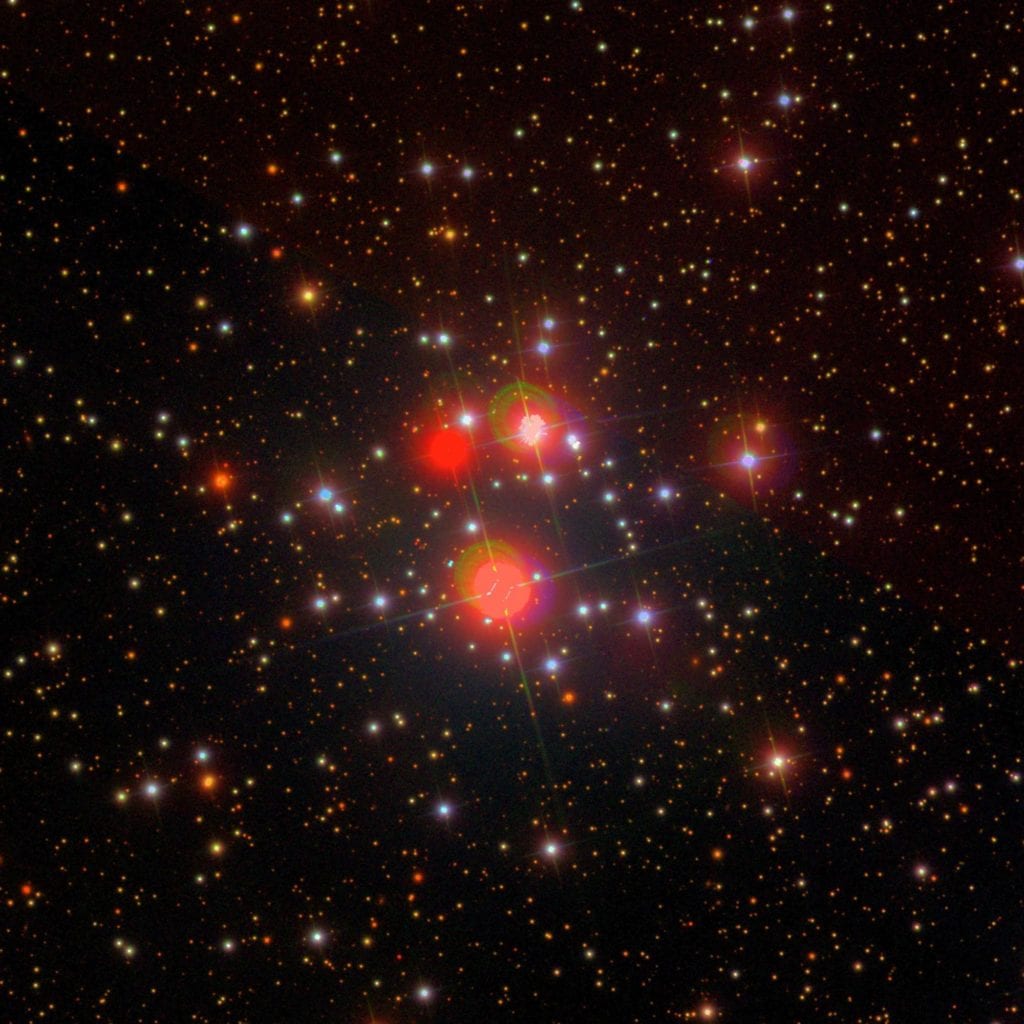The Gemini constellation is located in the northern celestial hemisphere and is among the 88 modern constellations. Its name means “the twins” in Latin and it represents the twins Castor and Pollux (Polydeuces) in Greek mythology. Polydeuces was later to lend the name to one of Saturn’s moons.

Gemini contains 10 named stars. The star names approved by the International Astronomical Union (IAU) are Alhena, Alzirr, Castor, Jishui, Mebsuta, Mekbuda, Pollux, Propus, Tejat and Wasat. There is only one Messier object in the constellation of Gemini but there are two meteor showers associated with the constellation — the Geminids and the Rho Geminids.
There are also several interesting deep sky objects in Gemini, such as the Eskimo Nebula, the Medusa Nebula, the open cluster NGC 2158 and neutron star Geminga. Currently, around 8 stars have been confirmed to host planets in the constellation.
History and Mythology Of The Gemini Constellation
Like other zodiac constellations, Gemini was first catalogued by the Greek astronomer Ptolemy in the 2nd century.
In Greek mythology, the constellation of Gemini was associated with the twins Castor and Pollux. The twins were the children of Leda, a Spartan queen, and they are also associated with the Argonauts. The brothers were also known as the Dioscuri, which means “sons of Zeus.” In most versions of the myth, however, only Polydeuces was Zeus’ son, and Castor was the son of the mortal King Tyndareus of Sparta.
When Castor, the mortal brother, died, Pollux begged his father Zeus to give his brother immortality, and Zeus did so, uniting them in the heavens. The two brightest stars in the constellation, Alpha and Beta Geminorum, mark the twins’ heads.
However, not everyone identified the constellation as Castor and Polydeuces in ancient times. Hyginus and Ptolemy associated the two stars with Apollo and Heracles, who were half-brothers and both sons of Zeus.

Location Of The Gemini Constellation
As we mentioned above, Gemini is the 30th largest constellation in the sky. It occupies 514 square degrees and lies in the second quadrant of the northern hemisphere (NQ2). It can be seen at latitudes between +90° and -60°.
Its right ascension is 7h and its declination is +20°. It is best viewed at 9pm during the month of February. The Sun will move through Gemini from June 21 to July 20 through 2062.
Gemini belongs to the zodiac family of constellations, along with Aries, Taurus, Cancer, Leo, Virgo, Libra, Scorpius, Sagittarius, Capricornus, Aquarius and Pisces. The neighboring constellations are Auriga, Cancer, Canis Minor, Lynx, Monoceros, Orion and Taurus.

Notable Stars
There are a number of notable stars in Gemini, with Pollux and Castor being the most famous.

Pollux
Pollux, also known as Beta Geminorum, is the brightest star in the constellation of Gemini and the 17th brightest star in the night sky. It is an evolved orange giant with the stellar classification K0 III.
It has an apparent magnitude of 1.14 and is located 33.78 light years distant from the Solar System. Pollux has a mass that is twice that of the Sun’s and has a radius that is nine times that of the Sun’s.
In June 2006, an extrasolar planet, Pollux b, was confirmed to be orbiting the star. It has a mass at least 2.3 times that of Jupiter and an orbital period of 590 days.

Castor
Castor, also known as Alpha Geminorum, is the second brightest star in Gemini and the 44th brightest star in the sky. It is a binary star with a combined apparent magnitude of 1.58. The two components are separated by 6” and have a revolution period of about 467 years.
The two components of Castor each have a spectroscopic binary star, which makes Castor a four-star system. Castor also has a faint companion about 72” away, which is an eclipsing binary star system with a period of just under a day.
Both components of the system are red (class M) dwarfs making Castor a sextuple star system, as all six of its components are gravitationally bound together. The primary component belongs to the spectral class A1 V and its companion is believed to be of spectral type M5 V. The secondary component stars have the stellar classifications A2 Vm and M2 V.

Alhena
Alhena, also known as Gamma Geminorum, has an apparent magnitude of 1.915 and is visible to the naked eye. It is a white subgiant star with the stellar classification A1 IV and is roughly 109 light years away from Earth. Around 123 times more luminous than the Sun, Alhena has a mass that is 2.8 times that of the Sun and a radius that is 3.3 times that of the Sun.
Its name comes from the Arabic Al Han’ah, which means “the brand,” referring to the brand on a camel’s neck. It is also sometimes known as Almeisan, which means “the shining one” in Arabic culture.
Mebsuta
Mebsuta, also known as Epsilon Geminorum, is a supergiant belonging to the spectral class G8 Ib. It has an apparent magnitude of 3.06 and is roughly 840 light years away from us. It marks Castor’s outstretched right leg.
Mebsuta has 19 solar masses and 105-175 times the solar radius. It is about 8,500 times more luminous than the Sun. The star lies close to the ecliptic and can be occulted by the Moon and planets.
The name Mebsuta comes from the ancient Arabic Mabsūṭah, which means “the outstretched paw”. It is also sometimes called Melboula or Melucta.
Tejat Posterior
Tejat Posterior, also known as Mu Geminorum, is the fourth brightest star in the Gemini constellation with a visual magnitude of 2.857. It is a red giant that belongs to the spectral class M3 III, but is also classified as a slow irregular variable of type LB. It is located about 230 light years away from us.
Its magnitude varies from 2.75 and 3.02 over a period of 72 days and the star has a period of 2,000 days of long term variation. The star’s traditional name means “the back foot,” and it refers to Castor’s foot.
Tejat Prior
Tejat Prior, also known as Eta Geminorum, is a multiple star that consists of three components — a spectroscopic binary star and class G0 dwarf star that orbits the pair with a period of over 700 years.
It is located 350 light years from Earth, near the ecliptic. It can occasionally be occulted by the Moon and, very rarely, by a planet.
The primary component of the binary system is a semi-regular variable star and a red giant with the spectral classification M3IIIlab. Its brightness ranges between magnitude 3.15 and 3.9. The secondary star is of the spectral type B and orbits the red giant with a period of 8.2 years.
Alzirr
Alzirr, also known as Xi Geminorum, is a yellow-white subgiant star belonging to the spectral class F5 IV. Its name means “the button” in Arabic and it marks one of the four feet of the Gemini twins. With a magnitude of 3.35, it is bright enough to be seen without binoculars.
Alzirr is 58.7 light years away from Earth and is about 11 times more luminous than the Sun. The star is a rapid rotator, with a projected rotational velocity of 66 km/s. It is suspected to be a spectroscopic binary.

Wasat
Wasat, also known as Delta Geminorum, is a yellow-white subgiant star with the stellar classification F0 IV. It has a visual magnitude of 3.53 and is visible to the naked eye. It is located around 60.5 light years away from us and is thought to be about 1.6 billion years old.
Wasat is located two-tenths of a degree south of the ecliptic and is sometimes occulted by the Moon and much less frequently by planets. It is really a triple star system, with the inner stars in the system forming a spectroscopic binary with components orbiting each other with a period of 6.1 years.
The binary system has a class K companion that orbits the primary component with a period of 1,200 years and can be seen in a small telescope. Delta Geminorum is a very fast rotator with a projected rotational velocity of 129.7 km/s.
The name Wasat means “middle” in Arabic. The star is also sometimes known by its Chinese name, Ta Tsun.
Kappa Geminorum
Kappa Geminorum is a multiple star system with the stellar classification G8 IIIa. It is located around 143 light years from our Solar System and has an apparent magnitude of 3.57. It is 78 times more luminous than the Sun.
Lambda Geminorum
Lambda Geminorum has an apparent magnitude of 3.58 and is classified as a variable star. It belongs to the spectral class A3 V and is thought to be around 800 million years old.
It is located around 94.3 light years away from us. This variable star is 28 times more luminous than the Sun and has 2.8 times the Sun’s radius. It also has 2.1 times the Sun’s mass.

Propus
Propus, also known as Iota Geminorum, belongs to the spectral class G9III. It has an apparent magnitude of 3.78 and is approximately 326 light years away from us. Its name means “the forefoot” in Latin.
Mekbuda
Mekbuda, also known as Zeta Geminorum, is an intermediate luminosity supergiant and a variable star classified as a Classical Cepheid. Its luminosity varies over a period of 10.148 days and its magnitude varies between 3.68 to 4.16. Mekbuda is about 2,900 times more luminous than the Sun.
Its name comes from ancient Arabic and means “the lion’s folded paw”.
Tau Geminorum
Tau Geminorum is an orange giant with the stellar classification K2 III. Under good conditions, it can be seen without binoculars. It has an apparent magnitude of 4.42 and is located around 321 light years away from the Solar System.
It is around 224 times more luminous than the Sun and has twice it’s mass. Tau Geminorum also has 27 times the Sun’s radius. Tau Geminorum b is a brown dwarf companion of Tau Geminorum. It was discovered in 2004 and has 18.1 times the mass of Jupiter. It takes 305 days to complete an orbit around the primary star.
U Geminorum
U Geminorum is a dwarf nova — a binary star composed of a white dwarf that closely orbits a red dwarf star. Discovered by the English astronomer John Russell Hind in 1855, the star has an outburst every 100 days and this causes a dramatic increase in luminosity.
Located around 400 light years away from the Sun, U Geminorum has an apparent magnitude that varies from 14.0 to 15.1, but during an outburst, the system can reach 9th magnitude, making it 100 times brighter.
The two binary stars of U Geminorum orbit each other with a period of 4 hours and 11 minutes. The stars eclipse each other with each revolution.
Deep Sky Objects
There are a number of interesting deep sky objects in Gemini, including nebulae and clusters. There is only one Messier object in Gemini.
Messier 35
Messier 35, also known as NGC 2168, is the only Messier object in the constellation of Gemini. It is an open cluster that is located around 3,870 light years away from Earth. It was discovered in 1745 by astronomer Phillippe Loys de Chesaux.
Messier 35 has an apparent magnitude of 5.1, meaning that it can be seen easily with a small telescope. It has a radius of around 11 light years and is believed to be around 175 million years old, containing around 1,600 solar masses.
NGC 2158
NGC 2158 lies directly southwest of Messier 35, around 11,000 light years distant from the Sun. It is an open cluster with an apparent magnitude of 8.6. It is thought to be about a billion years old.

Eskimo Nebula
The Eskimo Nebula, also known as NGC 2392 and Caldwell 39, is a bipolar double-shell planetary nebula that is surrounded by a layer of gas that used to form the outer layers of a star similar to the Sun. Sometimes, this nebula is also called the Clown Face Nebula.
The Eskimo Nebula can be observed in a small telescope and has an apparent magnitude of 10.1. It is located around 2,870 light years away from the Solar System.

Jellyfish Nebula
The Jellyfish Nebula, also known as IC 443 or Sharpless 248, is a Galactic supernova remnant that can be found near the bright star Eta Geminorum. It is located around 5,000 light years from Earth and is believed to be a remnant of a supernova that occurred 3,000-30,000 years ago. It is around 70 light years in size.
Medusa Nebula
The Medusa Nebula, also known as Sharpless 2-274 and Abell 21, is a planetary nebula near the border with Canis Minor. It was first discovered by UCLA astronomer George O. Abell in 1955 and is believed to be quite old and quite large, measuring more than four light years across.
It has an apparent magnitude of 7.68 and is approximately 1,500 light years away from the Solar System.
At first, it was believed to be a supernova remnant. However, in the 1970s, Soviet astronomers confirmed it was most likely a planetary nebula. The nebula was formed when a red giant turned into a hot white dwarf and shed its outer layers.
Geminga
Geminga is a neutron star, meaning it is a decaying core of an old massive star that ended its life in a supernova explosion about 300,000 years ago. It has an apparent magnitude of 25.5 and is approximately 815 light years distant from the Sun.
Geminga was the first example of a radio-quiet pulsar and the first unidentified gamma-ray source to be discovered.
IC 444
IC 444 is a small reflection nebula in Gemini that stretches out for around 32 square arcminutes. It has an apparent magnitude of 7.03.

NGC 2129
NGC 2129 is a young open cluster with an apparent magnitude of 6.7. It is located around 7,200 light years distant from the Sun, inside the Local spiral arm, a minor spiral arm of the Milky Way.
The brightest stars in the cluster are two close B-class stars that are believed to form a binary system. The NGC 2129 cluster is thought to be 10 million years old.
NGC 2371-2
NGC 2371-2 is a planetary nebula and a dual lobed nebula, meaning it looks like it could be two different objects. Because of this, it has two entries in the New General Catalogue — NGC 2371 and NGC 2372.
It can be seen with an amateur telescope and is located around 4,400 light years distant from Earth, to the southwest of the bright star Castor. It was first discovered by William Herschel.
NGC 2355
NGC 2355 is an open cluster composed of old stars, beloved to be a billion years old. It has a visual magnitude of 9.7 and is approximately 5,400 light years away from us.
Meteor Showers
There are two meteor showers associated with the constellation of Gemini — the Geminids and the Rho Geminids.
The Geminids are very bright, peaking on December 13-14. The Geminids are one of the richest meteor showers, with around 100 meteors per hour recorded during their peak.
The Rho Geminids peak between October 18 and October 29. They overlap with the Orionids, and this can make them difficult to detect. However, they have a higher velocity than the Orionids.
Extra Facts
- As of 2002, the Sun appears in the constellation of Gemini from June 21 to July 20.
- In tropical astrology, the Sun is considered to be in the sign Gemini from May 21 to June 22.
- In Babylonian astronomy, the stars Castor and Pollux were known as the Great Twins. The Twins were regarded as minor gods and were called Meshlamtaea and Lugalirra, meaning respectively ‘The One who has arisen from the Underworld’ and the ‘Mighty King’.
- In Chinese astronomy, the stars of Gemini are located in two areas: the White Tiger of the West, and the Vermillion Bird of the South.
Images:
- Some Images created with the NightVision app – https://www.nvastro.com/nvj.html
- Some Images created with the Stelvision Sky Map https://www.stelvision.com/en/sky-map/
- Gemini 1 – https://www.thoughtco.com/how-to-find-the-gemini-constellation-4184822
- Gemini 2 – https://starregistration.net/constellations/gemini-constellation.html
- Pollux – https://earthsky.org/brightest-stars/pollux-not-castor-is-geminis-brightest-star
- Castor – https://earthsky.org/brightest-stars/best-castor-brightest-second-magnitude-star
- Alhena – https://www.star-facts.com/alhena/
- Wasat – https://in-the-sky.org/data/object.php?id=TYC1359-2672-1
- Propus – https://theskylive.com/sky/stars/propus-eta-geminorum-star
- Eskimo Nebula – https://en.wikipedia.org/wiki/Eskimo_Nebula
- Jellyfish Nebula – https://apod.nasa.gov/apod/ap130109.html
- NGC 2129 – https://en.wikipedia.org/wiki/NGC_2129